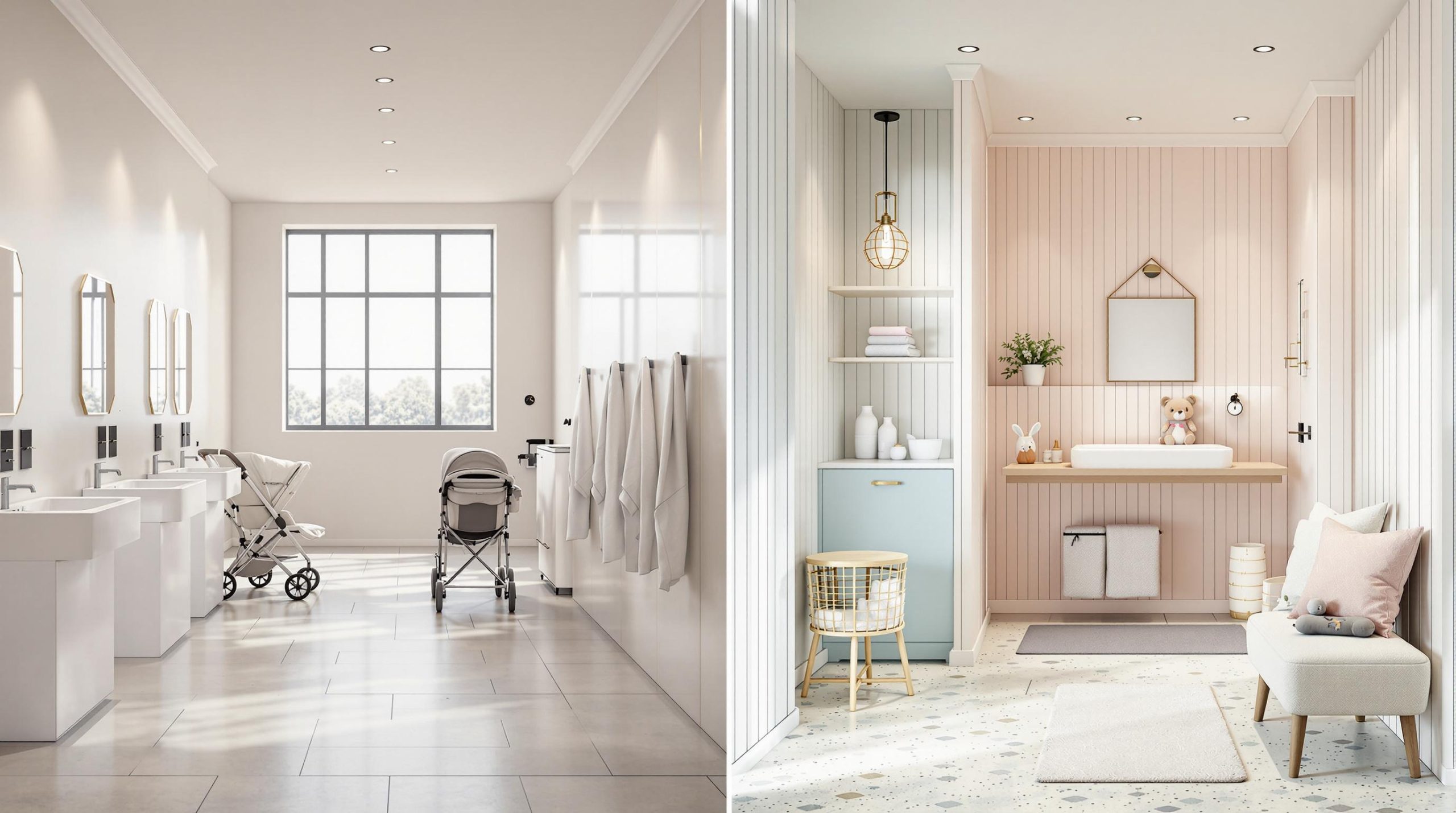
Public vs Private Baby Changing Facilities in London
London offers two types of baby changing facilities: public and private. Public facilities are widely available in parks, transport hubs, and community spaces, often charging a small fee (around 50p). Private facilities, found in department stores, cafés, and cultural venues, provide more comfort and extra services but may require a purchase or only be accessible during business hours.
Key Points:
- Public Facilities: Easy to find, cheaper, but basic and cleanliness varies.
- Private Facilities: Cleaner, more amenities (e.g., nursing rooms, bottle warmers), but fewer locations and tied to purchases.
- Digital Tools: Apps like BubbaMaps and the City of London’s toilet map help locate over 100 baby-changing spots.
Quick Comparison:
| Aspect | Public Facilities | Private Facilities |
|---|---|---|
| Location Coverage | Found in parks and public spaces | Limited to specific venues |
| Cost | 50p fee (often) | Free for customers or with purchase |
| Cleanliness | Varies | Higher standards |
| Amenities | Basic | Extras like nursing rooms |
| Availability | Some open 24/7 | Business hours only |
Use digital tools to plan your outings and balance convenience with comfort when choosing between public and private options.
Public Baby Changing Facilities
Location and Access
London offers public baby changing facilities in many busy areas, ensuring convenience for parents on the go. The City of London operates attended facilities in spots like Tower Hill and Paternoster Square, which can be accessed with a RADAR key or for a small fee. These facilities are part of a larger network that includes transport hubs, parks, and community spaces.
Finding these facilities is easier with digital tools like BubbaMaps and Toilets 4 London. For example, the Royal Festival Hall provides free baby changing options, complementing the accessibility offered by the Community Toilet Scheme.
Features and Conditions
The quality and features of public baby changing facilities can vary. Some, like the Barbican Centre‘s Changing Places facility, offer advanced amenities such as height-adjustable benches, hoist systems, and showers. However, most standard facilities are equipped with basic changing tables and handwashing stations. While these meet essential needs, cleanliness and upkeep can differ between locations. It’s a good idea for parents to bring sanitizing wipes and hand sanitizer for added peace of mind.
Pros and Cons
| Advantages | Disadvantages |
|---|---|
| Easy to find across the city | Maintenance and cleanliness can vary |
| Free or low-cost options available | Limited hours at some locations |
| Digital maps make navigation simple | Basic amenities in many facilities |
| Designed to include disabled parents | Queues may form during busy times |
| Supported by the Community Toilet Scheme | Cleanliness issues in crowded areas |
Public facilities are convenient and widely accessible, but private options often offer greater comfort and extra features. We’ll dive into those next.
Private Baby Changing Facilities
Types and Locations
In London, private baby changing facilities are commonly found in department stores, cafés, and cultural venues. For instance, John Lewis offers family rooms with changing tables and breastfeeding areas, making it a go-to spot for parents. Popular café chains like Café Nero and Costa also provide baby changing amenities at certain locations. Meanwhile, venues like the Barbican Centre include changing facilities in both male and female restrooms, along with accessible toilets spread throughout the building.
Additional Services
The Barbican Centre goes the extra mile by offering staff support and premium amenities, making it a family-friendly destination. Similarly, the Marquis of Westminster combines modern, clean facilities with attentive service, creating a welcoming space for families.
Some of the available amenities include:
- Private nursing rooms with temperature control
- Family-friendly seating areas
- High chairs and bottle warmers
- Tracking hoist systems
- Accessibility features designed for ease of use
Pros and Cons
| Advantages | Disadvantages |
|---|---|
| Maintained to high cleanliness standards | May require a purchase to access |
| Professionally managed and serviced | Only available during business hours |
| Offers additional family services | Fewer locations compared to public facilities |
| Climate-controlled spaces | Can get crowded at peak times |
| Staff assistance available | Often limited to customers |
For parents, choosing between public and private facilities often comes down to prioritizing comfort or accessibility. While private options provide a more comfortable experience and extra services, they may not always be as readily available as public alternatives. A closer comparison of public facilities will follow.
Would your baby changing facility pass the mummy blogger test?
sbb-itb-a5e9dda
Comparison of Public vs Private Facilities
When looking at baby changing facilities across London, public and private options have distinct features. The City of London’s 49 Community Toilet Scheme highlights the accessibility of public facilities, while private venues like John Lewis and the Barbican Centre provide more upscale experiences with extra conveniences.
Key Differences
Here’s a breakdown of the main contrasts between public and private facilities:
| Aspect | Public Facilities | Private Facilities |
|---|---|---|
| Location Coverage | Found in parks, museums, and public spaces | Limited to specific venues and business hours |
| Cost | Typically 50p per use in City of London | Free for customers or with purchase |
| Cleanliness | Maintained by municipal cleaning schedules | Frequently cleaned to higher standards |
| Special Needs Support | Available at select locations like the Barbican Centre | Varies depending on the venue |
| Additional Services | Basic changing setups | Extras like nursing rooms and bottle warmers |
| Staff Support | Rare or unavailable | Commonly present |
| Opening Hours | Some open 24/7 | Tied to business hours |
| Finding Facilities | Accessible via digital tools | Listed on venue websites and apps |
Examples like the Royal Festival Hall and Selfridges represent some of the best public and private facilities. For families with special needs, the Barbican Centre’s Changing Places provides features like hoists and height-adjustable benches.
The Barbican Centre stands out for its tailored approach to special needs, while public facilities benefit from initiatives like the Community Toilet Scheme to ensure broader access. Private facilities, though more comfortable and well-maintained, are often less convenient for longer outings.
Digital tools make it easier to locate these facilities, helping parents better plan their trips – a topic explored further in the next section.
Tips for Using Baby Changing Facilities in London
Using Apps and Tools
Finding baby changing facilities in London is much easier with the help of digital tools. Apps like BubbaMaps and the City of London’s interactive toilet map give you real-time information on more than 100 locations. These include reviews, costs, accessibility features, and whether the facilities are public or private – making it simpler to pick the best option for your needs.
Here’s what these platforms typically provide:
| Feature | Information Provided |
|---|---|
| Opening Hours | Real-time availability |
| Access Costs | Standard 50p charge for public facilities |
| Special Access | Details for RADAR key holders |
| Facility Type | Baby changing, accessible toilets, family rooms |
| Location Details | Directions and nearby landmarks |
Planning Family Outings
Outings with babies can be less stressful with a bit of preparation. Many modern venues now include several baby-friendly facilities, making them great options for families. Here are some tips to keep in mind:
- Use department stores like John Lewis or restaurant chains such as Prezzo and Pizza Hut as reliable stops.
- Carry a portable changing mat for unexpected situations.
- Check out participants in the Community Toilet Scheme, which offer free access to their facilities during business hours.
Facility Etiquette
When using baby changing facilities, keep these basic etiquette tips in mind:
- Always clean the station both before and after use.
- Dispose of waste in the appropriate bins.
- Notify staff if you notice any maintenance issues.
Conclusion
Public restrooms, like those at Paternoster and Tower Hill, are accessible for a small fee of 50p. On the other hand, private options such as John Lewis or Prezzo provide a more comfortable and clean experience but often require a purchase.
The availability of facilities across London boroughs differs significantly. For example, Wandsworth offers 21 baby-changing facilities in women’s restrooms and three in men’s, while Merton has none available for men.
When traveling around London with infants, parents have to weigh several factors when choosing between public and private facilities:
- Availability: Public restrooms are more common but may have limited hours. Private facilities are tied to business operating times.
- Cleanliness: Private facilities typically maintain higher hygiene standards.
- Extra Features: Many private locations include family rooms and additional amenities.
- Cost: Public facilities come with a small fixed fee, while private ones are generally free but often tied to a purchase.
Tools like BubbaMaps can help parents locate facilities that best match their priorities, whether they value convenience or comfort. Richmond’s Community Toilet Scheme is a great example of how collaborations with businesses can make these services more accessible.
Knowing these options allows parents to navigate London with greater ease and confidence.













